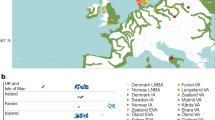Abstract
ABOUT 1912 the many interesting experiments in sheep-breeding carried out at Colesbourne by the late H. J. Elwes directed the attention of both sheep breeders and wool users to the many types of sheep, wild and domesticated. It was left to Prof. Cossar Ewart, of the University of Edinburgh, to evolve from the primitive characters and types a key scheme explanatory of the origin of the present-day breeds of domestic sheep. This he did by referring all breeds back to two fundamental types, namely, the Urial-Moufflon, which still has representatives in Asia, Europe, and America, and the fat-tail-fat-rump, based on the Ovis ammon, which seems to be a special development to meet the changed environment following the drying up of the Gobi Sea. Many evidences of these two types of sheep are to be noted in carefully selected present day flocks (see NATURE, May 6, p. 595; 1922). FIG. l. Fia. 2.
This is a preview of subscription content, access via your institution
Access options
Subscribe to this journal
Receive 51 print issues and online access
$199.00 per year
only $3.90 per issue
Buy this article
- Purchase on Springer Link
- Instant access to full article PDF
Prices may be subject to local taxes which are calculated during checkout
Similar content being viewed by others
Author information
Authors and Affiliations
Rights and permissions
About this article
Cite this article
BARKER, A. Ovis astore, a Three-Coated Sheep. Nature 129, 128–129 (1932). https://doi.org/10.1038/129128a0
Issue Date:
DOI: https://doi.org/10.1038/129128a0
This article is cited by
-
The Shedding of Certain Fibres in the Goat of the Lamb
Nature (1932)
-
Ovis astore, a Three-Coated Sheep
Nature (1932)
Comments
By submitting a comment you agree to abide by our Terms and Community Guidelines. If you find something abusive or that does not comply with our terms or guidelines please flag it as inappropriate.



